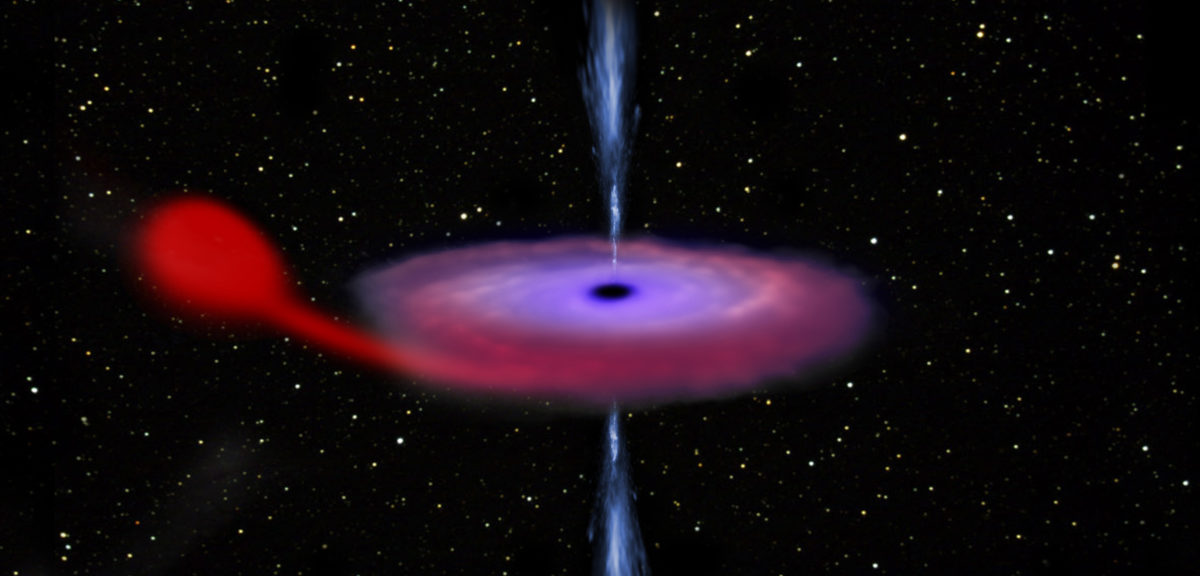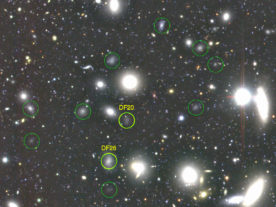
Artist’s impression of a black hole feasting on matter from its companion star in a binary system. (ESA/ATG medialab)
Some 8,000 light years from Earth, in the constellation Cygnus, a binary system known as V404 Cygni has come to life for the first time in 26 years.
While most binary systems consist of two stars orbiting a common center of mass, V404 Cygni is made up of a black hole and a star that orbit each other, with the black hole devouring matter from its companion.
In a system like V404 Cygni, material from the star pours out, heads toward the black hole and collects in an accretion disk, a circular object made of material that gathers around a black hole.
The incredibly powerful gravity produced by the black hole heats the disk and causes it to brilliantly shine at optical, ultraviolet and X-ray wavelengths until it spirals into the black hole and disappears.
But not all of the disk material winds up in the black hole. Scientists said some of it is ejected in the form of two powerful jets of particles
The binary system caught the attention of astronomers on June 15, 2015 when the Burst Alert Telescope, mounted on NASA’s Swift satellite, detected a sudden burst of gamma rays from V404 Cygni.
Once detected, the unexpected blast of extremely high frequency radiation then activated the satellite’s X-ray telescope to begin its observations of V404 Cygni.
A short time later, an X-ray flare originating from the same area as V404 Cygni was spotted by MAXI – Monitor of All-sky X-ray Image, part of the International Space Station’s Japanese Experiment Module.
The initial flurry of interest then set off a series of observations from ground-based and space telescopes around the world to monitor the black hole and its companion star at a variety of wavelengths that span the electromagnetic spectrum.
Erik Kuulkers, Integral project scientist at the European Space Agency (ESA), said V404 Cygni’s current behavior astonishes him and his colleagues, particularly its recurring flashes of bright light that last for less than an hour – something rarely seen in other black hole systems.
“In these moments, it becomes the brightest object in the X-ray sky – up to 50 times brighter than the Crab Nebula, normally one of the brightest sources in the high-energy sky,” said Kuulkers in an ESA press release.
Scientists said the last time the V404 Cygni system was as active and bright was back in 1989, when it was observed with the Japanese X-ray satellite Ginga, along with high-energy instruments mounted aboard the Mir space station.
Following that period of activity, the binary system began to quiet down again, allowing astronomers to finally see the black hole’s companion star, which had been obscured by the bright light produced by the outburst.
Referring back to the archival data gathered during the 20th century by various optical telescopes, astronomers found two previous outbursts. One occurred in 1938 and the other in 1956.
Scientists believe that the outbursts are triggered once the sheer amount of material within the surrounding accretion disk forces the black hole to dramatically increase its feeding mechanism – an event that takes place every two or three decades, said the scientists.
“Now that this extreme object has woken up again, we are all eager to learn more about the engine that powers the outburst we are observing,” said Carlo Ferrigno from the Integral Science Data Center at the University of Geneva, Switzerland.
























Comments are closed.